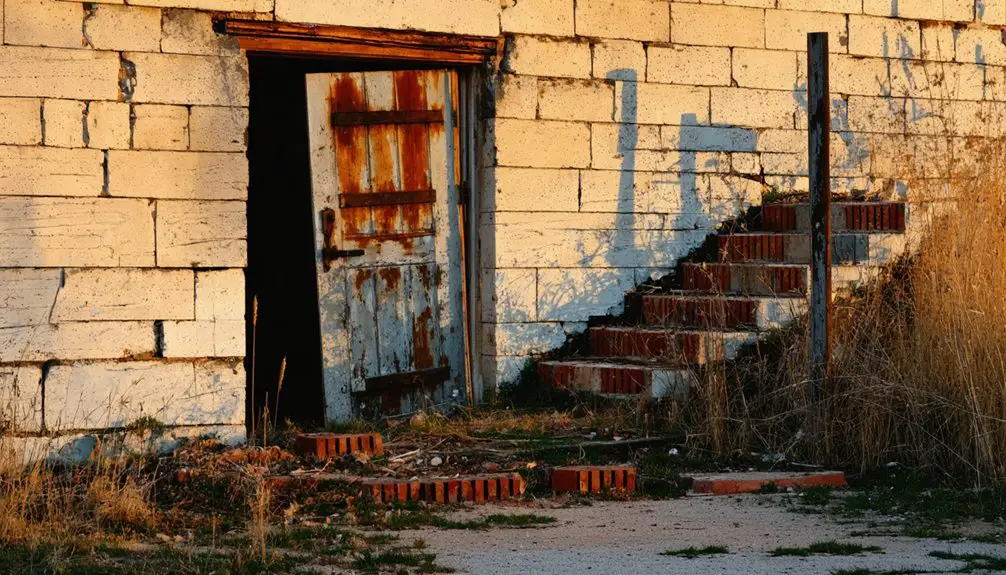You’ll find the ghost town of Lyceum, Oklahoma between the Arkansas and Canadian Rivers, where a prestigious Choctaw educational center once thrived. The town’s crown jewel was the Tvshka Homma Female Institute, built for $22,000 and led by Rev. Peter J. Hudson. After operating from the late 1800s, the institute’s destruction by fire in 1925 marked Lyceum’s decline. The ruins and barren fields today hold fascinating stories of Native American education and cultural preservation.
Key Takeaways
- Lyceum was a historic Choctaw settlement that became a ghost town following a devastating fire in 1925.
- The town was home to the prestigious Tvshka Homma Female Institute until its destruction by fire in the 1920s.
- Lyceum’s post office operated from 1889 to 1907, serving as a vital communication hub for the Choctaw Nation.
- The settlement’s decline accelerated after the 1925 fire destroyed essential businesses, leading residents to relocate to nearby Tuskahoma.
- Located between the Arkansas and Canadian Rivers, Lyceum’s remains are preserved through Oklahoma Historical Society documentation efforts.
The Rise of a Choctaw Educational Hub
When the Choctaw Academy opened its doors in 1825, it marked the beginning of a transformative educational movement for the Choctaw Nation.
You’ll find that this strategic investment in Choctaw education aimed to equip young tribal members with skills to protect their rights and lands.
The academy, located on Colonel Richard Morton Johnson’s Kentucky farm, welcomed an average of 150 students from various tribes under Reverend Thomas Henderson‘s leadership.
Under the guidance of Peter Pitchlynn as school superintendent, the academy prioritized academic excellence and cultural preservation.
Students received comprehensive instruction in reading and writing, along with advanced subjects like Latin, mathematics, astronomy, and surveying.
Life Around the Female Academy
You’d find the Tvshka Homma Female Institute bustling with activity under the leadership of Rev. Peter J. Hudson and later Miss Nellie Wakefield, who established rigorous academic standards while honoring Choctaw cultural traditions.
The teaching staff focused on preparing young women for tribal leadership through a blend of traditional subjects and cultural education, maintaining discipline and morality as core values. Similar to European lycée institutions, the school provided comprehensive academic preparation for higher education. The school was constructed at a cost of $22,000 to address the pressing need for female education in the region.
Students participated in community events centered around the school and its adjacent post office, creating a vibrant social atmosphere that defined the Lyceum settlement until the academy’s destruction by fire in the 1920s.
Daily Academy Life
Life at the Lyceum Female Academy revolved around a strictly regimented schedule that balanced academic pursuits with religious devotion. As a student, you’d start your day with morning prayers, followed by core academic classes in subjects like English, math, and science.
Throughout the day, you’d observe traditional Christian prayer times including Terce, Sext, and None, reflecting the academy’s deep spiritual practices. The academy’s focus on faithful Christian presence shaped every aspect of daily worship and study. Students who were caught speaking their native languages faced harsh punishments, reflecting the strict cultural assimilation policies of the era.
Your daily student routines included structured study periods and electives, all carefully designed to foster both intellectual growth and cultural assimilation.
You’d live in age-segregated dormitories under strict supervision, where discipline and order ruled every aspect of life. The demanding schedule required careful time management as you navigated between academic excellence, religious obligations, and community engagement.
Teaching Methods and Staff
The teaching methods at Lyceum Female Academy reflected a sophisticated blend of classical Christian education and innovative pedagogical approaches. The faculty’s teaching philosophy emphasized integrating multiple disciplines while serving dual roles as instructors and advisors.
You’d find teachers deeply engaged in fostering intellectual growth through thorough curriculum design and personalized mentoring. Drawing from a centuries-old tradition, the academy’s art instruction methods were particularly influential in shaping students’ creative development. Similar to Licciardello and Yager’s bold adaptations, teachers tailored classical works to create fresh, engaging learning experiences.
- Faculty members held advanced degrees in education and specialized disciplines
- Teachers implemented multi-dimensional assessments including portfolios and oral presentations
- Staff maintained strong advisor-advisee relationships throughout the two-year program
- Instructors integrated Truth, Beauty, and Goodness principles across all subjects
The academy’s faculty roles extended beyond traditional classroom instruction, creating an environment where students developed both academically and spiritually through project-based learning and community engagement.
This approach reflected their commitment to nurturing well-rounded, intellectually curious individuals.
Student Community Activities
Within the vibrant halls of Lyceum Female Academy, students immersed themselves in a rich tapestry of social and cultural activities that extended far beyond academic pursuits. You’d find young women organizing study groups, participating in academic clubs, and engaging in lively debates that sharpened their critical thinking skills. The school’s emphasis on intellectual formation guided all student interactions.
Community engagement flourished through organized visits to nearby Choctaw communities, while student camaraderie grew stronger during social gatherings, dances, and outdoor picnics. Regular opening receptions provided opportunities to connect with visiting artists and view diverse exhibitions.
The academy’s spiritual life centered on daily chapel services and moral instruction, complemented by artistic expressions through music, painting, and traditional Choctaw crafts. Students staged dramatic readings and poetry recitals, showcasing their talents while preserving their cultural heritage.
Through service activities and educational outreach, these young women built lasting connections with local families and maintained strong alumni networks.
Early Postal Operations and Community Services
During Lyceum’s most active period, postal operations served as an essential communication hub from 1889 until Oklahoma’s statehood in 1907.
You’ll find that these postal connections were significant for maintaining community interactions between Lyceum, the nearby town of Tuskahoma, and the broader Choctaw Nation. The post office supported the town’s educational institutions, particularly the Choctaw Female Academy, while facilitating governmental communications in the pre-statehood era.
- Supported the Choctaw Female Academy’s operations by handling student and administrative correspondence
- Facilitated communication between Lyceum and Tuskahoma’s government offices
- Connected families with students attending the prestigious girls’ school
- Enabled broader community engagement through mail services before modern telecommunications
These services proved essential in maintaining Lyceum’s position as an important cultural and educational center within the Choctaw Nation.
Geographical Significance in Indian Territory
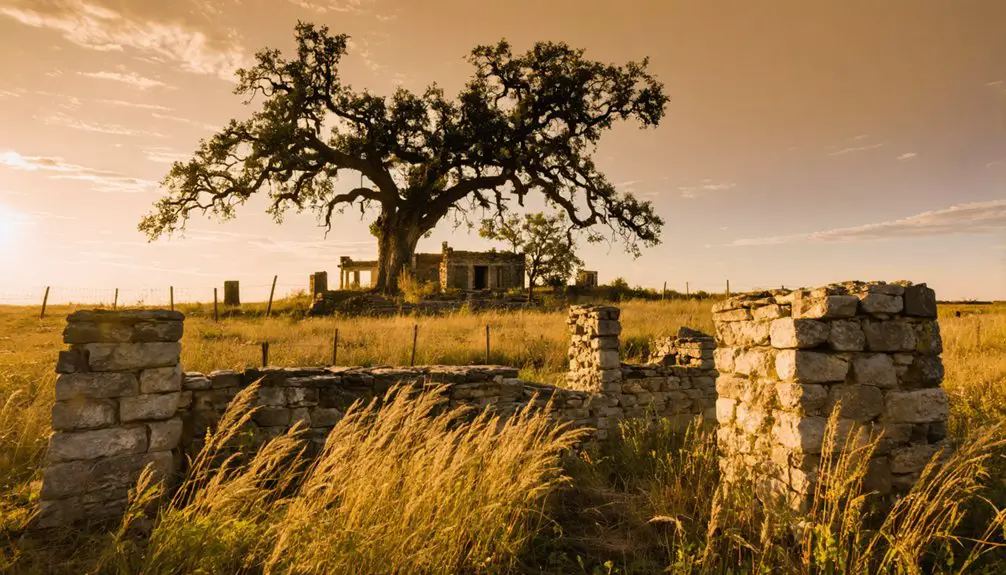
Located between latitudes 33° 25′ and 37° 00′ and longitudes 94° to 100° W, Indian Territory’s diverse landscape played a crucial role in shaping Lyceum’s development and regional significance.
You’ll find the settlement nestled within the rolling plains between the Arkansas and Canadian Rivers, where geographical diversity shaped the community’s access to essential resources and transportation routes.
As part of the broader tribal territories, Lyceum benefited from the region’s varied elevation, which ranges from 300 feet near the Red River to 3,000 feet in the northern areas.
The network of rivers, including the Arkansas and Canadian, provided natural corridors for trade and movement, while smaller tributaries like Ash Creek supported local agriculture and settlement patterns that defined the community’s placement within Indian Territory’s complex jurisdictional landscape.
Legacy of the Choctaw Capitol Building
You’ll find the Choctaw Capitol Building‘s most enduring legacy in its role as the nerve center of tribal governance from 1884 to 1907, where it housed all three branches of the Choctaw government.
The building’s distinctive red brick architecture and mansard roof, constructed at a cost of $25,000, stands as the finest example of late 19th-century Native American governmental buildings in Indian Territory.
Now serving as the Choctaw Nation Capitol Museum, this National Historic Place continues to preserve and showcase Choctaw history through exhibits, educational tours, and cultural events that draw over 100,000 visitors during its annual Labor Day festival.
Political Power Center
In 1879, the Choctaw Tribal Council set in motion a pivotal chapter in their nation’s history by planning a permanent seat of government, which culminated in the construction of the Capitol building at Tuskahoma. This political consolidation marked a significant evolution in governance, as you’ll find evidence of the Choctaw Nation’s determination to establish a lasting political foundation.
The Capitol’s strategic location, about 2.5 miles east of old Nanih Waiya, served as the heart of tribal authority until Oklahoma statehood in 1907.
- Three-story structure housed both legislative chambers and Supreme Court
- Annual General Council sessions began October 1884, establishing regular political proceedings
- Replaced previous centers like Armstrong Academy, centralizing administrative power
- Executive offices and committee rooms supported complex governmental operations
Architectural Heritage Preserved
Standing as a demonstration to Choctaw architectural ingenuity, the Capitol Building showcases locally sourced red clay bricks that were fired in on-site kilns, giving the structure its distinctive appearance due to high iron oxide content.
The building’s architectural significance shines through its three-story design, featuring a mansard roof and 11,404 square feet of meticulously planned space.
You’ll find well-preserved council chambers, executive offices, and a supreme courtroom that reflect the building’s historic stature.
The Choctaw Nation’s preservation efforts have secured its place on the National Register of Historic Places, ensuring its legacy as one of only four surviving tribal capitols of the Five Civilized Tribes.
Today, as the Choctaw Nation Capitol Museum, it continues educating visitors about tribal heritage while maintaining its physical integrity.
The 1925 Fire and Community Transformation
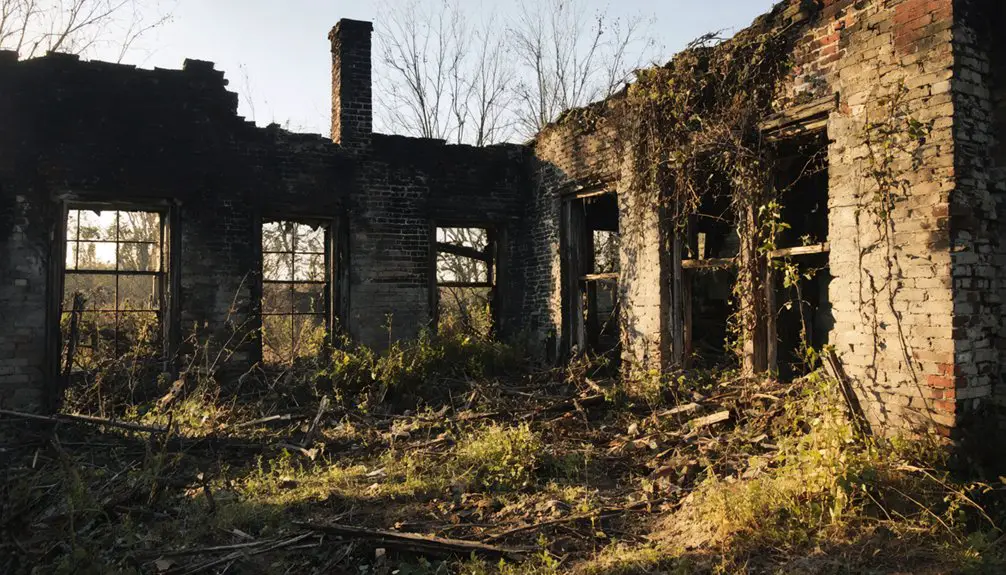
While Lyceum had been a bustling Oklahoma community in the early 1920s, the devastating fire of 1925 marked the beginning of its transformation into a ghost town. The fire aftermath swept through the town’s wooden structures, destroying essential businesses and homes.
Despite attempts at community resilience, limited insurance coverage and insufficient rebuilding resources forced many residents to seek opportunities elsewhere.
- Commercial establishments were permanently lost, crippling local employment
- Infrastructure deteriorated as population declined and maintenance ceased
- Former residential areas gradually returned to their natural state
- Social institutions like schools and churches couldn’t sustain operations
You’ll find that the fire’s impact rippled through every aspect of town life, accelerating Lyceum’s decline until it vanished from regional significance, leaving only scattered ruins as evidence of its existence.
Cultural Impact on Choctaw Nation
Before its transformation into a ghost town, Lyceum held profound cultural significance for the Choctaw Nation through its educational institutions and proximity to tribal governance centers.
You’ll find that the Choctaw Female Academy, established in 1892, played a crucial role in preserving Choctaw identity by educating young women in both traditional values and modern skills.
The town’s connection to nearby Tuskahoma, home of the Choctaw Capitol Building, created a powerful nexus of cultural preservation and political leadership.
Despite the challenges of post-removal adaptation, Lyceum represented the Choctaw Nation’s commitment to maintaining their heritage through strategic institutional development.
The town’s educational focus reflected broader tribal efforts to balance cultural traditions with necessary adaptations in Indian Territory, ensuring survival while protecting essential aspects of Choctaw identity.
Notable Structures and Historical Sites
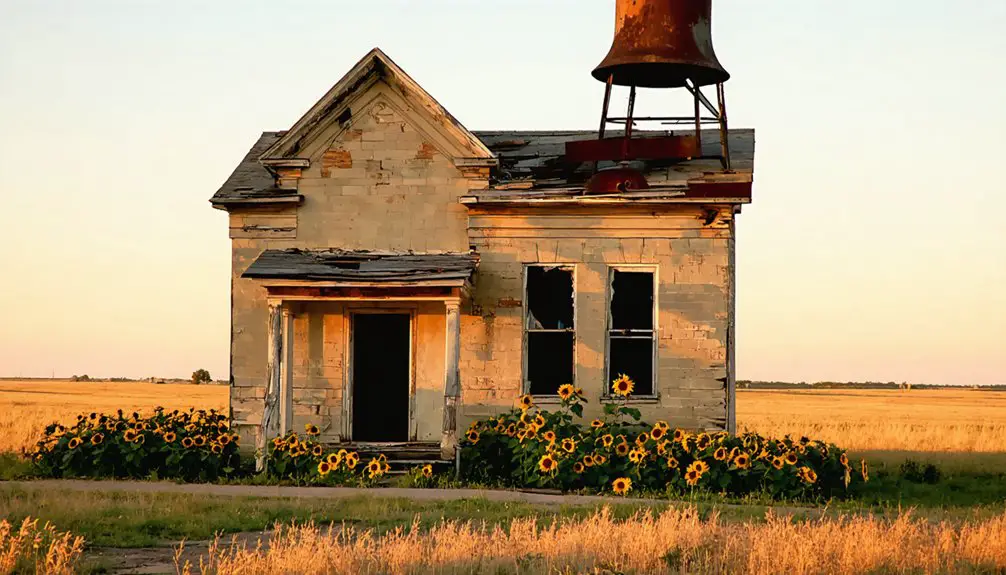
You’ll find two prominent architectural landmarks at the heart of Lyceum’s historical legacy: the Academy Building and the Capitol Building.
The Academy Building served as an educational center during the town’s peak, reflecting the architectural style common to missionary schools of the 1800s.
The Capitol Building, while smaller than many governmental structures of its era, held significance as a local administrative hub before the town’s eventual abandonment.
Academy Building History
Established in 1892, the Tvshka Homma Female Institute served as a cornerstone of education for young Choctaw women near Tuskahoma, Oklahoma. The academy architecture featured a two-story frame building that cost $22,000, housing different grade levels on each floor.
Under the leadership of Rev. Peter J. Hudson and later Nellie Wakefield, the academy created an educational legacy that lasted until 1925, when fire claimed the structure.
- Lower floor accommodated seventh and eighth-grade students
- Upper floor hosted ninth and tenth-grade classrooms
- Building included an on-site post office named “Lyceum”
- Facility served dual purposes as both school and community center
The academy’s presence symbolized the Choctaw Nation’s dedication to advancing women’s education, making it a significant landmark until its destruction transformed the community’s educational landscape.
Capitol Building Legacy
Two remarkable capitol buildings stand as symbols to Oklahoma’s rich governmental heritage.
The Oklahoma State Capitol showcases Greco-Roman neoclassical architecture with its Indiana limestone exterior and distinctive eight winged lions symbolizing regal victory. The Capitol’s architectural significance grew in 2002 when the long-planned dome was finally added, crowned by “The Guardian,” a 22-foot bronze sculpture.
You’ll find another example of Capitol symbolism in Pushmataha County, where the historic Choctaw Capitol Building, built in 1884, now serves as the nation’s museum.
This structure, listed on the National Register of Historic Places, features a war veterans’ memorial honoring the Choctaw Code Talkers and hosts an annual Labor Day festival drawing over 100,000 visitors.
From Academic Center to Abandoned Settlement
Although Lyceum began as a promising academic center built around the Choctaw Female Academy in 1892, its shift into an abandoned settlement occurred through a series of setbacks and demographic shifts.
You’ll find this academic decline particularly evident in the early closure of its post office by 1900, followed by the devastating fire that destroyed the Female Academy in 1925.
These events accelerated Lyceum’s path to becoming a ghost town, as residents migrated toward the nearby town of Tuskahoma.
- The Female Academy served as both an educational hub and community anchor
- Change from Wade County, Choctaw Nation to Oklahoma statehood impacted local dynamics
- Loss of postal services signaled early infrastructure decline
- Fire of 1925 marked the final turning point toward abandonment
Historical Preservation Efforts and Memory
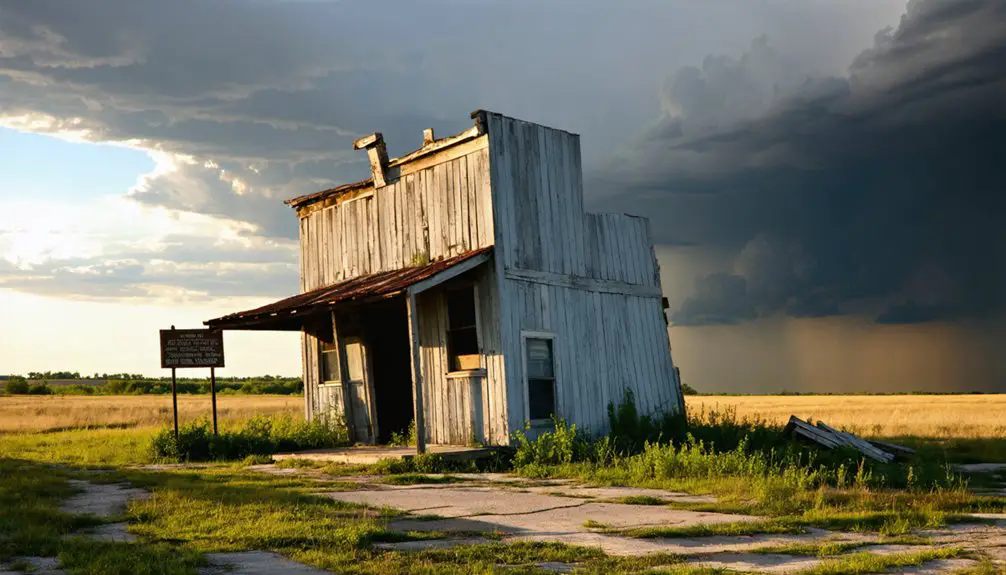
Since the early 2000s, Oklahoma’s preservation organizations have launched systematic efforts to document and protect Lyceum’s remaining historical legacy.
The Oklahoma Historical Society and University of Oklahoma’s Western History Collection have been at the forefront of ghost town preservation, gathering artifacts and stories that highlight Lyceum’s unique role in the state’s educational history.
You’ll find Lyceum featured in detailed documentation projects that distinguish it from other Oklahoma ghost towns, thanks to careful research using over 1,200 sources.
Digital and print initiatives now preserve the cultural memory of this former academic center, while museum exhibits and publications tell the human stories behind its decline.
These preservation efforts guarantee that Lyceum’s contribution to Oklahoma’s historical narrative won’t be forgotten, even as its physical structures continue to fade.
Frequently Asked Questions
What Was the Total Student Enrollment at the Choctaw Female Academy?
You’ll find the exact enrollment at Choctaw Female Academy isn’t documented, but historical records of similar Choctaw education institutions suggest numbers ranged between 40-138 students during its period of historical significance.
Were There Any Notable Graduates From the Choctaw Female Academy?
You won’t find documented alumni achievements or notable figures from this academy – historical records of graduates were likely lost in the 1925 fire that ultimately destroyed the school’s main buildings.
What Caused the 1925 Fire That Destroyed the Academy?
You won’t find the exact cause in historical records, as fire investigation details weren’t preserved. While similar Oklahoma school fires of that era involved Christmas tree candles, Lyceum’s specific trigger remains undocumented.
Did Any Original Buildings From Lyceum Survive to Present Day?
You won’t find any original structures from Lyceum standing today. While historical preservation efforts document many Oklahoma ghost towns’ remaining buildings, there’s no evidence that any of Lyceum’s buildings survived.
What Was the Peak Population of Lyceum During Its Most Prosperous Years?
Like many mysteries lost to time’s shadows, Lyceum’s exact peak population isn’t documented in historical records. You’ll find its history follows typical Oklahoma ghost town patterns, suggesting several hundred residents before population decline.
References
- https://en.wikipedia.org/wiki/Lyceum
- https://www.youtube.com/watch?v=5d-wHDTIbb0
- https://www.okhistory.org/publications/enc/entry?entry=GH002
- https://www.youtube.com/watch?v=wSt3RYWLw2I
- http://www.ou.edu/news/articles/2024/may/ou-researcher-unveils-book-of-oklahomas-ghost-towns.html
- https://www.choctawnation.com/news/iti-fabvssa/the-choctaw-academy-investing-in-future-choctaw-leaders/
- https://blog.oup.com/2017/03/enlightened-nation-choctaw-education/
- https://www.choctawnation.com/about/eps/brownfields/wheelock-academy-a-legacy-of-education-and-complexity/
- https://www.okhistory.org/publications/enc/entry?entry=CH049
- https://www.hmdb.org/m.asp?m=221153
